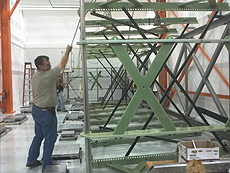Construction begins on largest liquid-argon time projection chamber in the U.S.
 |
| John Voirin, PPD, works on the construction of the liquid-argon time projection chamber. Photo: Jennifer Raaf, PPD
|
If everything goes according to plan, in 2014 Fermilab will fire up the largest liquid-argon time projection chamber to be built in the United States. The device will be the heart of the laboratory's MicroBooNE experiment, which physicists hope will confirm whether there are just the three known types of neutrino oscillations or if more exist – a possibility that's been badgering scientists for nearly two decades.
Until recently, the LArTPC was merely drawings on paper and some stacked and stored metal slabs. However, Fermilab now has all the parts necessary to build the chamber's body. MicroBooNE collaborators and Fermilab technicians began construction earlier this month.
"When the LArTPC is finished, it will be about the size of a school bus and weigh around 5 tons," said one of MicroBooNE's construction managers, Jennifer Raaf.
In general, when it comes to TPCs, bigger is better. The larger the chamber, the more material scientists can stuff inside it, which in turn means more particle collisions and better statistics. In the LArTPC's case, the material will be roughly 170 tons of extremely pure liquid argon – a substance that will allow scientists to detect what kind of particles are born from collisions between neutrinos, protons and neutrons.
In addition to its importance for MicroBooNE, demonstrating the LArTPC technology is important for the proposed LBNE experiment, which would use a similar device to detect neutrinos.
In spring of 2013, the MicroBooNE collaboration will have finished building the LArTPC and will move it from its current location, the DZero assembly building, to its permanent home at the eventual Liquid Argon Test Facility.
Once the LArTPC is installed, physicists will use the Booster neutrino beam to shoot muon neutrinos at the TPC's center. They will then study the resulting outburst of particles, with hopes of detecting a certain excess of low-energy, electron-like events, like the one that was first observed in MicroBooNE's cousin experiment, MiniBooNE, back in 2007.
This excess could be evidence for an exotic fourth type of neutrino or it could be the result of background contamination. The LArTPC will distinguish between the two.
MiniBooNE, a Cherenkov-type detector, can't distinguish between an event triggered by background photons and an event triggered by electrons because they look very similar.
"But in MicroBooNE, photons convert to a pair of particles that will deposit twice as much energy as electrons, so we should be able to easily tell the difference," Raaf said.
After two months of carefully cleaning every beam, bolt and wire to minimize contamination, Raaf and her team are well on their way to finishing the chamber's frame by the end of this winter. So far, the task has been challenging but fun and informative, said University of Cincinnati graduate student Ryan Grosso.
"Nowadays in high-energy physics you never get to build your detector," Grosso said. "So it's really exciting for a graduate student to be able to say, 'I helped build my detector and now I will take data and analyze that data,' as opposed to just taking data."
One of the more difficult aspects of construction, Raaf said, is getting everything to fit together.
"Unfortunately, it's not the same as IKEA instructions," Raaf said with a laugh. "But that's okay because we have an outstanding team working on this project."
—Jessica Orwig
|